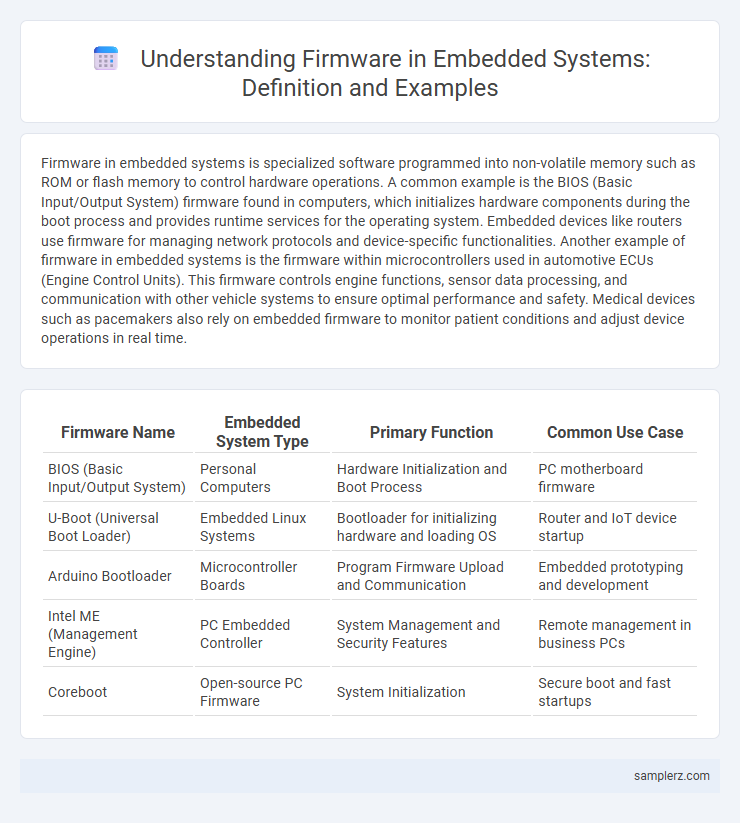Firmware in embedded systems is specialized software programmed into non-volatile memory such as ROM or flash memory to control hardware operations. A common example is the BIOS (Basic Input/Output System) firmware found in computers, which initializes hardware components during the boot process and provides runtime services for the operating system. Embedded devices like routers use firmware for managing network protocols and device-specific functionalities. Another example of firmware in embedded systems is the firmware within microcontrollers used in automotive ECUs (Engine Control Units). This firmware controls engine functions, sensor data processing, and communication with other vehicle systems to ensure optimal performance and safety. Medical devices such as pacemakers also rely on embedded firmware to monitor patient conditions and adjust device operations in real time.
Table of Comparison
| Firmware Name | Embedded System Type | Primary Function | Common Use Case |
|---|---|---|---|
| BIOS (Basic Input/Output System) | Personal Computers | Hardware Initialization and Boot Process | PC motherboard firmware |
| U-Boot (Universal Boot Loader) | Embedded Linux Systems | Bootloader for initializing hardware and loading OS | Router and IoT device startup |
| Arduino Bootloader | Microcontroller Boards | Program Firmware Upload and Communication | Embedded prototyping and development |
| Intel ME (Management Engine) | PC Embedded Controller | System Management and Security Features | Remote management in business PCs |
| Coreboot | Open-source PC Firmware | System Initialization | Secure boot and fast startups |
Introduction to Firmware in Embedded Systems
Firmware in embedded systems refers to specialized software programmed directly into hardware components, enabling critical control and communication functions. Examples include BIOS in computers, microcontroller firmware in devices like smart thermostats, and firmware in automotive control units managing engine performance. This low-level code bridges hardware and higher-level software, ensuring device stability and efficient operation.
Understanding Embedded System Architecture
Firmware in embedded systems typically includes bootloaders, device drivers, and real-time operating systems (RTOS) that directly manage hardware resources like microcontrollers and sensors. Understanding embedded system architecture involves analyzing how this firmware interacts with hardware components such as memory units, communication interfaces, and input/output devices to perform dedicated functions. Efficient firmware design ensures seamless integration and real-time responsiveness essential for applications in automotive, industrial automation, and consumer electronics.
The Role of Firmware in Device Functionality
Firmware in embedded systems is critical for managing hardware operations and enabling device functionality by directly controlling processors and peripherals. Examples include BIOS in computers, which initializes hardware during startup, and the firmware in IoT devices that manages sensor data and communication protocols. This low-level software ensures reliable performance, seamless hardware integration, and facilitates firmware updates to improve features or security.
Common Examples of Firmware in Consumer Electronics
Firmware in consumer electronics typically includes BIOS in personal computers, which initializes hardware during startup and manages data flow between the operating system and peripherals. Another prevalent example is the firmware in smart TVs, which controls display settings, network connectivity, and streaming applications to enhance user experience. Embedded systems in digital cameras rely on firmware to manage image processing, sensor operation, and storage functions efficiently.
Firmware in Automotive Embedded Systems
Firmware in automotive embedded systems controls critical functions such as engine management, anti-lock braking, and airbag deployment, ensuring real-time response and system reliability. Examples include Electronic Control Units (ECUs) firmware that manages sensor data and actuators to optimize vehicle performance and safety. Automotive firmware updates enhance features, fix vulnerabilities, and comply with regulatory standards, making them essential for modern vehicle operation.
Firmware Applications in Industrial Automation
Firmware in embedded systems drives critical industrial automation applications such as programmable logic controllers (PLCs), motor controllers, and robotic arms, enabling precise control and real-time monitoring. These firmware programs ensure seamless communication between hardware components and higher-level control systems, optimizing manufacturing efficiency and reliability. Industrial firmware often incorporates cybersecurity features to protect against unauthorized access and maintain operational integrity in harsh environments.
Firmware Use Cases in IoT Devices
Firmware in embedded systems plays a crucial role in IoT devices by directly managing hardware functions such as sensors, actuators, and communication modules. Examples include smart thermostats where firmware controls temperature data acquisition and network connectivity, and wearable health monitors that rely on firmware to process biometric data in real-time while ensuring secure data transmission. Efficient firmware updates also enable IoT devices to maintain security and performance, adapting to evolving network protocols and user requirements.
Medical Device Firmware Examples
Medical device firmware examples include pacemaker control systems, insulin pump software, and ultrasound imaging device firmware, all crucial for ensuring real-time monitoring and precise therapeutic functions. These embedded firmware systems enable continuous data acquisition, signal processing, and device calibration while maintaining strict compliance with regulatory standards like FDA and IEC 62304. Robust firmware updates and error handling mechanisms enhance device reliability and patient safety in critical healthcare applications.
Security Considerations for Embedded Firmware
Embedded firmware such as BIOS firmware in computer motherboards and microcontroller firmware in IoT devices requires robust security measures to prevent unauthorized access and tampering. Implementing secure boot processes, firmware encryption, and regular updates are critical to defending against vulnerabilities and cyberattacks targeting embedded systems. Security considerations also include proper authentication mechanisms to ensure firmware integrity and protect sensitive data within embedded devices.
Future Trends in Embedded Firmware Development
Future trends in embedded firmware development emphasize the integration of artificial intelligence and machine learning algorithms to enhance device autonomy and predictive maintenance. Advances in secure boot and hardware-rooted trust architectures are driving improvements in firmware security, protecting against increasingly sophisticated cyber threats. The adoption of over-the-air (OTA) updates and modular firmware design enables seamless, real-time enhancements and scalability in complex embedded systems.

example of firmware in embedded system Infographic
 samplerz.com
samplerz.com